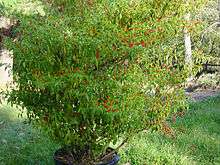Pequin pepper
| Pequin pepper | |
|---|---|
 Closeup of fruits, foliage, and flower | |
| Species | Capsicum annuum |
| Cultivar | Pequin |
| Heat |
|
| Scoville scale | 30,000–60,000 SHU |
Pequin (or piquín) pepper (/pɪˈkiːn/) is a hot chili pepper cultivar commonly used as a spice. Taxonomically, it is classified within variety glabriusculum of the species Capsicum annuum.[1]
Pequin has a compact habit, growing typically 0.3–0.6 meters tall, with bright green, ovate leaves and small berries that rarely exceed 2 cm in length. Like most chilies, the berries start out green, ripening to brilliant red at maturity. Pequin peppers are very hot, often 5-8 times hotter than jalapeños on the Scoville scale (30,000 to 60,000 Units). Flavor is described as citrusy, smoky (if dried with wood smoke), and nutty.[2]

The name Pequin is thought to come from the Spanish pequeño, meaning small.[3] Its fruit is oblong and is found in the wild from the American Southwest to the Andes.[3] It is grown both wild and commercially harvested in Mexico.[3]
Common uses include pickling, salsas, sauces, soups, and vinegars. The Cholula brand hot sauce lists piquin peppers and chile de arbol peppers among its ingredients.[4]
Pequin peppers are highly valued in Mexico, often costing more than 10 times the price of other peppers, but their cultivation is limited due to low seed germination (15% average germination rate) and susceptibility to disease. Pequins prefer moderate shade levels (35% shade) and daily watering, though they are drought tolerant. In the wild, Pequins grow in the understory of trees as perennials; under cultivation, they are grown as annuals as disease susceptibilities limits their growth. Seeds germinate in 7 to 28 days, require 60 to 90 days for seedling development, and require 90 to 100 days after transplant to produce commercial fruit. [5]
If frost damaged pruning off the top may allow for the plant to sprout again if the roots were not damaged.[6][7]
See also
References
- ↑ Marco Antonio Alvarado Vázquez; Alejandra Rocha Estrada; Sergio Mereno Limón, eds. (2010). De la Lechuguilla a las Biopelículas Vegetales: Las Plantas Útiles de Nuevo León (PDF). Universidad Autónoma de Nuevo León.
- ↑ Miller, Mark (1991). The Great Chile Book. Berkeley, California: Ten Speed Press. pp. 124–125. ISBN 0-89815-428-6.
- 1 2 3 Bosland, Paul W.; Iglesias, Jaime (1992). "'NuMex Bailey Piquin' Chile Pepper" (PDF). HORTSCIENCE. 27 (8): 941–942. Retrieved 12 March 2018.
- ↑ "Nutrition Information", Cholula Website Archived 2013-06-27 at the Wayback Machine., Last accessed 02 Jul 2009
- ↑ Valiente-Banuet, Juan I.; Gutiérrez-Ochoa, Alejandro (1 May 2016). "Effect of Irrigation Frequency and Shade Levels on Vegetative Growth, Yield, and Fruit Quality of Piquin Pepper (Capsicum annuum L. var. glabriusculum)". HortScience. pp. 573–579. Retrieved 17 August 2017.
- ↑ "Chile Pequin and Chiltepin | Central Texas Gardener". www.klru.org. Retrieved 12 March 2018.
- ↑ "Chile Pequin". Cypress Basin Master Gardeners. 27 October 2016. Retrieved 12 March 2018.